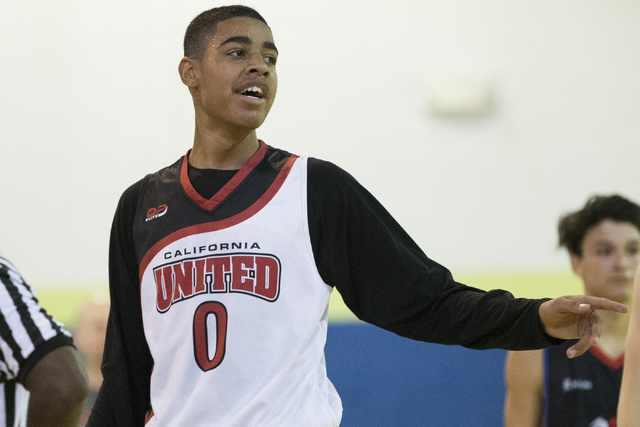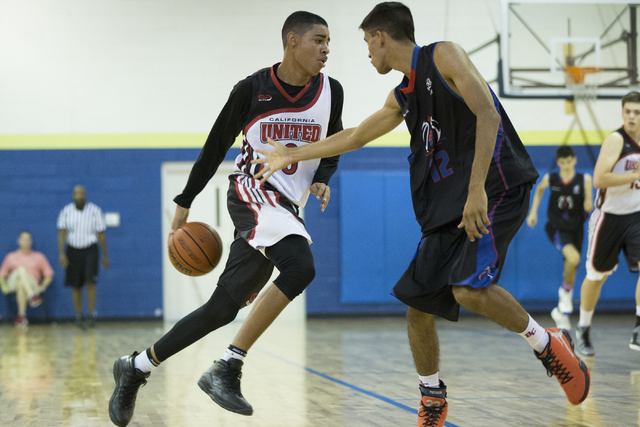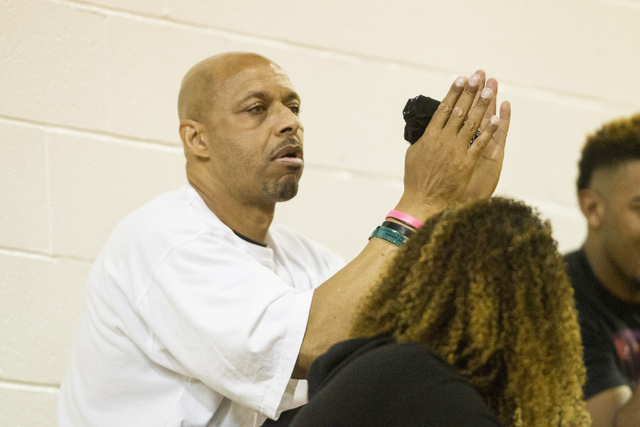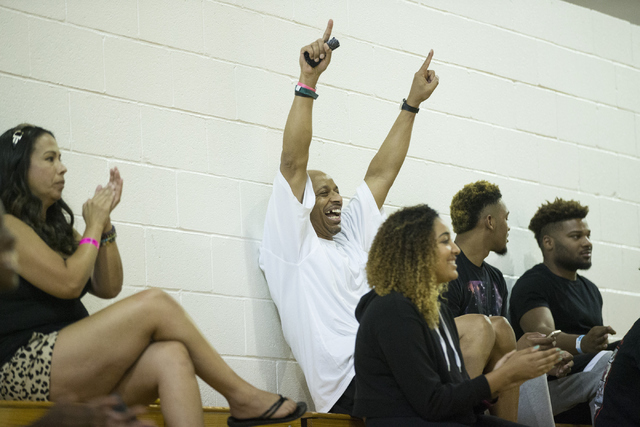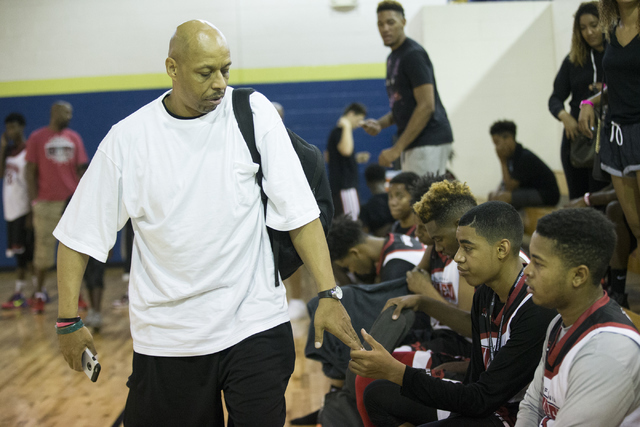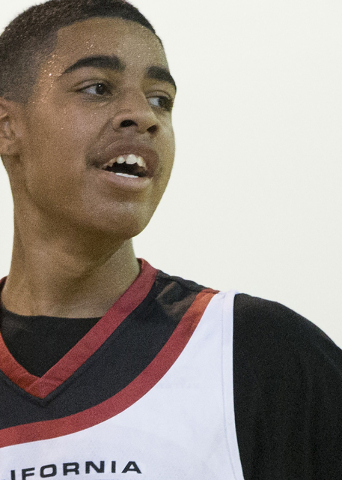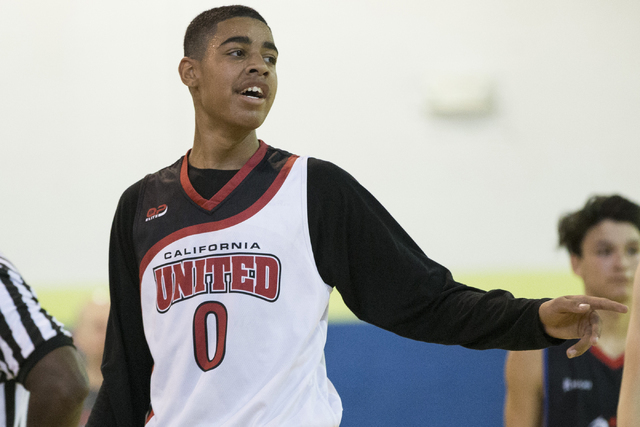Recruiting Game: Recruiting evolves from simple to complex in Information Age
Lee Strawther had one scholarship offer. It was from Drake University in Iowa. Then he broke his wrist midway through his senior season of basketball at Valley High School in 1979.
Then the people in Iowa weren’t so interested.
A few players in Las Vegas were more seriously recruited around that time. Danny Tarkanian and Mike Brown at Bishop Gorman. Michael “Spider Man” Burns at Chaparral. But most who were good enough didn’t always graduate from prep courts directly to those of major college programs.
Even the youngest son of the late Jerry Tarkanian began his career at what was then known as Dixie College.
It makes you wonder why more local players weren’t noticed at exposure camps or through AAU travel teams or by all those fancy recruiting services that attach stars to the names of players and now rank — because isn’t it a matter of life and death that we know? — the best fifth-graders in the country.
(In case you’re wondering, No. 1 is LeBron James Jr. We hear his father is pretty good, too.)
“There wasn’t any of that when we were growing up,” Strawther said. “No AAU. Nothing. We had an All-Star team from Las Vegas that played in some tournaments against teams from California, but that’s about it. I never saw this coming, how things are with recruiting now. Nobody could have.”
The beast that is college recruiting in all sports is something in 2016 that would rival any pit fighter on “Game of Thrones,” an evolution whose growth from simple to complex over decades is hardly an uncomplicated terrain to navigate.
It can be as seedy as it is expansive, as much about the next profile update as the next payoff.
Over the next six days, we will attempt to traverse that daunting and at times disturbing landscape by analyzing many of the different aspects that create the recruiting culture as it exists today, where it began and how it progressed, the good and bad of it, the highs and lows, when what might appear to be a bright light of positivity suddenly becomes another dark badge of misconduct.
Which doesn’t mean we’re doing an entire series on Southeastern Conference football.
Strawther is an ideal canvas on which to depict the world of recruiting then and now, having received a small taste of it as a player growing up in Las Vegas and over the past few years being force-fed an entire mouthful.
His daughter Paris is a sophomore forward on the UNLV women’s basketball team who received several scholarship offers coming out of Liberty High.
But it’s his son, Julian, whose talent will introduce to the family a completely different level of the recruiting madness, a runaway train that is just now departing the station.
Julian is about to begin his freshman year at Liberty. As his game blossomed over the past year, the national interest in him began to accelerate by the day.
Florida State and UNLV already have offered scholarships.
Many more will follow.
“I just want to focus on playing, but it’s cool to see people are recognizing me for it,” Julian said. “I have really high expectations and just need to stay true to myself. Having certain schools interested in you is exciting, but outside of playing and getting better, I’m going to let my dad handle everything else.”
Lee Strawther has buckled himself in for the ride.
It can be a bumpy one.
GENERATION SELFIE
Pick a sport. It’s as true with soccer and golf as it is the almighty monster of football: Recruiting was never the same once that period in human history characterized by the shift from traditional industry to an economy based on computerization morphed into its current model.
In other words, things changed forever once the world stopped talking and began clicking.
It became a 24/7 adventure.
It never stops.
Did you ever believe Mark Zuckerberg played such a pivotal role in college recruiting?
The progression of the Information Age might have been a deliberate one — do you remember that brick and concrete building with all the books called a library? — but once coaches were able to reach prospects via countless forms of technology, Pandora’s box opened like the wallet of a booster when enticing certain recruits.
“None of us had a clue things would grow to what they have now,” said Bob Gibbons, who is based in North Carolina and for decades has run one of the nation’s leading prep basketball recruiting services. “The internet and social media changed everything because of how easy it is for coaches now to get to prospects, from Facebook to Twitter and Instagram. I remember a time when all my reports on players were done on a typewriter, put in an envelope and mailed out. Now, I email and Google.
“But you can’t hold onto the past, even though I enjoyed those times more. There wasn’t the sense of entitlement with kids that you have today, all being told by parents and colleges how great they are. Everyone is the next Kobe Bryant or LeBron James. Everyone is going to the NBA.”
There is a reason for such grandiose promises: The pressure on college coaches to win in all sports has never been more intense.
Division I-A football costs millions to field, but it also can make millions. Members of Power 5 conferences annually divvy up revenues from network TV contracts and the largest bowl games. The immense amounts of cash distributed to league members if one of its teams, say, makes the College Football Playoff, often doubles the entire annual budget of some non-Power 5 athletic departments.
Those sorts of dollar figures and the expectations to deliver on them, along with their own rising salaries, have led to coaches beginning the recruiting process earlier and earlier, which often leaves more time for shenanigans to occur as scholarship offers are made.
“That’s really one of the biggest issues now with recruiting as opposed to 20 years ago,” said Frank Burlison, a Hall of Fame basketball writer who operates a scouting service for college and NBA teams. “Right now, you could have a particular basketball program having already offered 12 guards in the class of 2019. What if, one day, eight families all decide that’s the school for them? What does the coach do then?
“Years ago, it was about 200 handwritten letters to a prospect. Now, the pressure to offer kids earlier and earlier before other schools is out of control. But it looks good for the kid’s travel team coach, who can say schools A, B and C have all offered one of his eighth-graders.
“It’s all about attention now, exposure, that social media element. Used to be, a coach could have a home visit with a kid and conduct a private interaction with him and his family and maybe the high school coach. Now, that conversation is all over the internet 15 minutes after the college coach leaves. Most kids are driven by the attention, by the recruiting rankings, by getting as many early scholarship offers as they can.”
As time passed and the mode of communication in recruiting became more and more sophisticated, so, too, did methods of cheating. Boosters delivering bags of untraceable cash to elite recruits probably still occurs, but such ways mostly have been replaced by agents or runners for agents identifying potential professional athletes early in the process and providing gifts for a future working relationship, agreements that are often reneged on later by the prospect.
Things are more advanced now when it comes to gaining an unfair advantage, one reason the massive tome of rules in regard to football recruiting pushes near 400 pages.
Crazy. It only took Kurt Vonnegut 215 to give us “Slaughterhouse-Five.”
Paper trails are still followed by the NCAA’s enforcement staff, but they’re becoming tougher to identify. Cold cash, homey, has been replaced with more complex, innovative ways to line pockets. A recruit is just as apt to receive payment in casino chips and gift cards or even a house for Mom and Dad as he is a stack of $100 bills.
But quantifying how large an issue cheating remains isn’t easy. It obviously happens. It was recently reported that football and men’s basketball were involved in 83 percent of major Division I infractions from 1953 to 2014, the most common being those in recruiting with such things as inducements and impermissible benefits.
This, however, is also true: While thousands of secondary violations are recorded annually, lost among those and the high-profile cases involving the best of the best in a particular sport, are folks still doing things the right way.
“Take basketball,” Burlison said. “You have 360-plus Division I teams with 13 scholarships annually. Do the math. Any given year, maybe 20 to 30 guys make the NBA. But we tend never to focus on all those who don’t make the pros or were never going to, kids who received free educations and went on to become teachers and doctors and lawyers and businessman and positive, upstanding members within their communities.
“There are dirty, seedy people in politics, in business, in the medical field, in every field. It’s also true in coaching and recruiting. But there is still more good than bad in it. I really believe that. The recruitment of thousands of young men and women athletes each year still leads to more long-term positive ripple effects on society than not.”
GUIDING THE SON
Julian Strawther reached 6 feet 6 inches tall last month, a wing player who concluded a highly successful summer campaign in which he played on travel teams out of Henderson and California while securing an invitation to the prestigious Chris Paul Camp in North Carolina.
Strawther hasn’t played with his own age group in two years.
He’s 14, and the train is rumbling down those tracks.
Lee Strawther has been approached by many who believe if he held his son back a year in school, his basketball future and recruiting potential would become even greater over time. That happens a lot. Kids stay back all the time. Julian won’t.
“He’s a good student, and it’s more important to me that he’s a well-rounded, happy kid going to school with the classmates he grew up with,” Lee said. “It was never a serious option for us. Julian is going to control most of this process by how hard he works and how bad he wants it. In the end, I just want him happy. Basketball will take care of itself.”
Their latest journey into the world of recruiting begins again with the spiritual presence of Lourdes Strawther, Lee’s wife and the mother of their three children who lost her battle with breast cancer in August 2011.
She was known to everyone as Cookie.
When his daughter Paris began hosting coaches for home visits, Lee had Julian sit in on the meetings and ask his own questions, preparing him for a process that the father understood his son might one day experience firsthand.
Now, as the son begins his freshman year of high school and his recruitment becomes more and more intense, the father searches for ways to keep the impending storm from becoming a virtual tropical cyclone.
“Julian is very grounded and has gone through a lot of things with my wife passing away just after he finished the third grade,” Lee said. “He had to grow up fast. But fortunately, all three of the kids really bonded and came together and held each other up. His older sisters (Paris and Paige) are very protective of him. If their mother were here, she’d be running the show and would probably have the final say or a big influence with what happened with the recruiting process. I admitted a long time ago that I can’t do it by myself.
“I know the process can get pretty grimy, dirty, cutthroat. But we’re going to keep Julian in a bubble as much as we can, keep things quiet and in the gym working. I’m proud of him. I’m excited for him. We just never thought it would begin this fast.”
It wouldn’t have 20 years ago, but recruiting is no different from most things.
Times change, for better and, often, for worse.
Ed Graney can be reached at egraney@reviewjournal.com or 702-383-4618. He can be a heard on “Seat and Ed” on Fox Sports 1340 from 2 p.m. to 4 p.m. Monday through Friday. On Twitter: @edgraney



